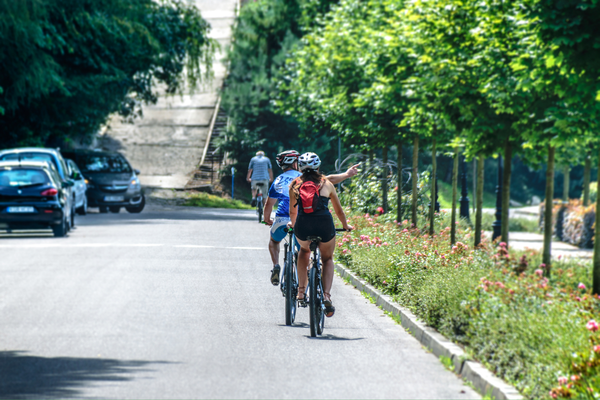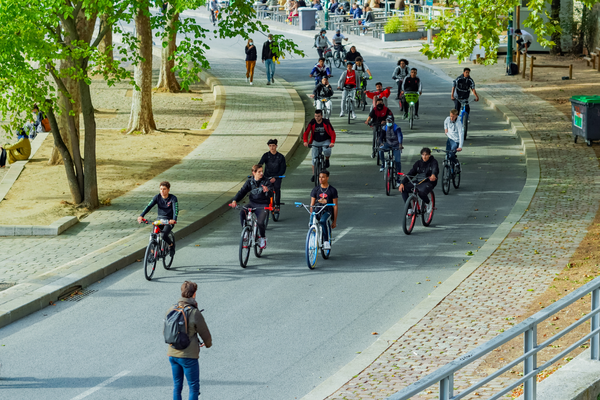Are you confused about bicycle laws in Rock Hill, SC? Many people are. Both riders and drivers express uncertainty about rules for sidewalks, stop signs, and helmets. This confusion is common in a city like Rock Hill, which actively promotes cycling with fantastic resources like the Riverwalk and the Giordana Velodrome, yet still has busy streets like Cherry Road.
The single most important rule to understand is that under South Carolina law, a bicycle is legally defined as a vehicle. This classification means cyclists possess the same rights and carry the same responsibilities as drivers. This guide will clarify the 7 most frequent myths. The goal is to help you ride safely and legally, whether you are enjoying a family ride or navigating Old Town.
The Law Offices of Wilkerson Jones and Wilkerson wants to provide clear, correct information for its Rock Hill neighbors. Knowing the actual law is the first step in preventing accidents. Misunderstanding the rules can lead to serious injuries and complex legal questions.
Myth 1: Are bicyclists considered pedestrians in Rock Hill?
Many people hold a firm belief that bicycles are “toys” or simply an extension of walking. They think bikes must stay on the sidewalk, completely separate from automobiles. This is a very common, and very dangerous, misunderstanding.
Fact: Bicycles are legally vehicles in South Carolina.
This is the most critical myth to correct. The law is not ambiguous. Under SC Code § 56-5-3420, a person riding a bicycle is “granted all of the rights and is subject to all of the duties applicable to the driver of a vehicle.”
What does this mean in practice? When a cyclist is on a Rock Hill street, such as Oakland Avenue or India Hook Road, that cyclist must follow all traffic laws just like a car. This includes the important rule of riding with the flow of traffic, never against it. A cyclist riding against traffic is invisible to drivers who are turning right and only looking left for oncoming cars.
This “vehicle” status also means a cyclist must signal turns when it is safe to do so, obey all lane markings, and yield the right-of-way when required. A driver who expects a cyclist to be on a sidewalk may be surprised to see one in the lane. A cyclist who understands their right to be in the lane will ride more predictably. This mutual understanding of a bicycle’s legal status is vital for safety. It changes the entire dynamic from “getting out of the way” to “sharing the road” as fellow vehicle operators.

Myth 2: Is it illegal to ride a bike on the sidewalk in Rock Hill?
This is the complete opposite of Myth #1, and its existence creates significant confusion. Many drivers are adamant that cyclists are never permitted on any sidewalk, at any time. This belief is also not entirely correct.
Fact: SC law allows sidewalk riding, but local rules apply (and you must yield to pedestrians).
South Carolina state law does not feature a statewide ban on sidewalk riding. It does, pointedly, give cities and municipalities the authority to create their own specific rules for their own business districts and parks.
In Rock Hill, there is not a complete, city-wide ban on riding a bicycle on the sidewalk. With that said, it is generally prohibited and unsafe in high-traffic pedestrian zones. This includes the busy sidewalks within Old Town’s business district, where pedestrians and shop patrons create a crowded environment.
There is one golden rule that is absolute: The law is perfectly clear on this point. If a cyclist is on a sidewalk, that cyclist has the legal status of a pedestrian. This means the cyclist must always yield the right-of-way to any person on foot. The cyclist must also give an audible signal (like “passing on your left!” or ringing a bell) before passing. A pedestrian should never be surprised or frightened by a bicycle coming quickly from behind.
From a human experience standpoint, riding on the sidewalk is also dangerous for the cyclist. Drivers pulling out of driveways, parking lots, or side streets are not looking for a fast-moving bicycle on the sidewalk. They are looking for pedestrians, and they are looking at the street for cars. A cyclist on a sidewalk is often invisible until it is too late.
Myth 3: Do bicyclists have to stop at stop signs in Rock Hill?
This is a major point of frustration for many drivers. They see cyclists treat stop signs as “yield” signs, only slowing down to check for traffic before proceeding. This is often called a “rolling stop” or, in states where it is legal, an “Idaho Stop.”
Fact: A stop sign means a full stop—even on a bike.
Yes. This is not a gray area in South Carolina. Because a bicycle is a vehicle, it must obey all traffic control devices. This requirement includes coming to a complete stop at stop signs. A “complete stop” means all forward momentum ceases. The cyclist must also stop behind the white stop bar at red lights, just as a car would.
From a human perspective, this law is difficult for cyclists. It takes a significant amount of physical energy to stop completely and then restart from zero. It breaks all momentum. This is why the “rolling stop” is so tempting. But it is illegal. This behavior erodes the trust between drivers and cyclists. A driver sees a bike roll a stop sign and feels the cyclist is breaking the rules and does not deserve to share the road. For a cyclist, obeying this law is a key part of demonstrating a commitment to safety and mutual respect.
South Carolina law does offer one unique exception, which is a high-value piece of information. This is often called the “stuck red light” law (SC Code § 56-5-970(C)). Many traffic lights are controlled by in-ground magnetic sensors. These sensors may not detect a bicycle. If a cyclist is at a red light and the light fails to change, the cyclist is not expected to wait forever. The cyclist must first wait at least 120 seconds (two full minutes). After waiting, and confirming the way is completely clear, the cyclist may proceed through the red light with extreme caution.
Myth 4: Can you get a DUI for riding a bike while intoxicated in Rock Hill?
If a person is too drunk to drive a car, it seems logical that the person would also get a Driving Under the Influence (DUI) charge for riding a bicycle. This is a reasonable assumption.
Fact: You cannot get a DUI, but you can be arrested.
No. South Carolina’s DUI laws (found in S.C. Code § 56-5-2930) apply with precision to “motor vehicles.” A bicycle is human-powered. It is not a motor vehicle under the DUI statute. A person cannot be charged with or convicted of DUI for riding a traditional bicycle.
This does not make it legal. A person can, and often will, still be arrested. If someone is on a bicycle and “grossly intoxicated” in a public place (a road or sidewalk is a public place), that person can be charged with public drunkenness or disorderly conduct under S.C. Code § 16-17-530. It is extremely dangerous, both for the rider and for others, and it remains illegal. An intoxicated rider has poor balance, delayed reactions, and poor judgment. This is a recipe for a serious accident.

Myth 5: Is it illegal to ride a bike without a helmet in Rock Hill?
People often assume that helmets are a legal requirement for all cyclists, regardless of age, much like seatbelt laws. This is one of the most common questions families have.
Fact: There is no state or local helmet law for adults in Rock Hill.
South Carolina has no statewide helmet law for bicyclists. Adding to this, the City of Rock Hill does not have its own local ordinance that requires helmets for adults or for children.
This is a critical distinction between what is “legal” and what is “safe.” While it is not the law, the Rock Hill Bicycle Club and virtually all safety and medical experts strongly advise wearing a helmet. A helmet is the single most effective piece of gear for preventing a serious head injury. This is a “safety vs. legality” issue. The choice to wear one is a personal safety decision, not a legal mandate.
After an accident, the decision to not wear a helmet can become a point of contention. The Law Offices of Wilkerson Jones and Wilkerson have seen the sad results of this choice. While not wearing a helmet does not make a cyclist at fault for an accident, it can complicate legal matters about the extent of injuries.
Myth 6: Is it illegal for cyclists to ride side-by-side in Rock Hill?
Drivers often express frustration when they see two cyclists riding next to each other. They feel the cyclists are improperly blocking the lane and should be in a single file line.
Fact: South Carolina law allows riding “two abreast.”
This belief is false. SC law (S.C. Code § 56-5-3430(D)) explicitly permits two cyclists to ride side-by-side in a single lane. This is called riding “two abreast.”
The law specifies they cannot ride more than two abreast. The only exception is on paths or parts of roadways set aside for the exclusive use of bicycles. The Rock Hill Riverwalk is a good example of such a path, where groups may ride wider if space permits.
From a safety perspective, riding two abreast is often safer for the cyclists. It makes the group a shorter, more visible, “car-like” object for a driver to see. It forces the driver to make a full lane change to pass, rather than trying to “squeeze by” in the same lane. It also shortens the length of the group, meaning the driver spends less time in the oncoming lane during the pass. As a matter of courtesy, many cycling groups will move to a single file formation to permit cars to pass safely when there is a long line of traffic.
Myth 7: Do cyclists have to ride in the gutter or shoulder?
Many believe a bicycle must be as far from traffic as physically possible. This includes riding on a dangerous, debris-filled shoulder or in the gutter, where glass, nails, and potholes are common.
Fact: Cyclists must ride “as far to the right as practicable” and can “take the lane” when necessary.
SC law (S.C. Code § 56-5-3430(A)) states a cyclist must ride as near to the right side of the roadway “as practicable.”
That word, “practicable,” is the most important part of the law. It does not mean “possible.” It does not mean in the gutter. A cyclist is legally allowed (and safety experts encourage it) to move to the center of the lane. This is known as “taking the lane.” This is a vital safety maneuver. It is proper and legal when:
- The lane is too narrow for a car and a bike to share safely side-by-side (like on many older Rock Hill streets).
- The cyclist is avoiding hazards like potholes, sewer grates, broken glass, or debris.
- The cyclist is preparing to make a left turn.
- The cyclist is moving at the same speed as traffic.
- The cyclist is passing a parked car, avoiding the “door zone” where a door could open suddenly.
A cyclist “taking the lane” is not doing it to be rude. They are doing it for safety. It makes the cyclist visible. It forces the car behind them to slow down and pass in the next lane, just as they would for a slow-moving moped or tractor. This action prevents a dangerous “side-swipe” in a narrow lane, which is a very common type of bicycle accident.
Know Your Rights. Ride Safely.
Knowing the truth about these common myths makes the roads safer for everyone in Rock Hill. A bicycle is a vehicle. By riding predictably and following the law, cyclists protect themselves and drivers.
If a person or a loved one has been in a bicycle accident, questions about rights will arise. The legal team at Law Offices of Wilkerson Jones and Wilkerson is here to help. This firm understands the specific laws that apply to cyclists in Rock Hill. Contact the Law Offices of Wilkerson Jones and Wilkerson today for a consultation. With over Many years of experience, the attorneys at this firm know how to handle complex cases. The Law Offices of Wilkerson Jones and Wilkerson provides this guide as a public service. For those injured, understanding your personal injury rights is the first step. You can learn more about our experienced legal team and its commitment to the Rock Hill community.
Frequently Asked Questions About Rock Hill Bike Laws
1. What is the “three-foot law” in South Carolina?
South Carolina has a safe passing law, S.C. Code § 56-5-3435. It states that a driver of a motor vehicle must pass a bicyclist at a “safe distance.” The law clarifies that a “safe distance” is at least three feet. This three-foot buffer provides a critical margin of safety. A driver must wait until it is safe to move over, allowing at least three feet of space, before passing a cyclist.
2. Are e-bikes (electric bikes) legal in Rock Hill?
Yes. South Carolina updated its laws to define electric-assist bicycles. E-bikes are generally treated the same as traditional bicycles, meaning they are allowed on roads and bike paths. The law defines them in classes. Class 1 and 2 e-bikes (which assist up to 20 mph) are typically permitted where regular bikes are. Class 3 e-bikes (assisting up to 28 mph) may have more restrictions. E-bikes are not considered mopeds or motorcycles.
3. Do I need lights on my bike in SC?
Yes, if you ride at night. S.C. Code § 56-5-3470 is very specific. Any bicycle used between sunset and sunrise must be equipped with a white light on the front, visible from at least 500 feet. It must also have a red reflector or a solid or flashing red light on the rear, visible from at least 300 feet. This is a vital safety law.
4. Can a cyclist get a speeding ticket?
Yes. Because a bicycle is a vehicle, all traffic laws apply. If a cyclist is riding on a street in Rock Hill with a posted speed limit of 25 mph, and they are clocked going 35 mph (which is possible on a steep hill), they can be cited for speeding just like a car. All speed limits, not just stop signs, apply.
5. What should I do if I am in a bike accident in Rock Hill?
First, move to a safe location if possible and call 911. Request both police and medical assistance. Get the driver’s name, insurance information, and license plate number. If there are witnesses, get their contact information. Take pictures of the scene, your bike, and the car. Do not admit fault. After you have received medical attention, contact an experienced attorney to understand your rights.
About Us
Attorney F. Craig Wilkerson, Jr. is a former Marine Corps officer with approximately 20 years of experience in personal injury and civil litigation.
Read more
Recent Posts
Initial Consultations with Attorneys in South Carolina
Holiday Driving Safety Tips from Your Rock Hill, SC Attorneys
Workers’ Compensation Watch Points Out Holiday Hazards
Holiday Safe Ride Strategies by Your Rock Hill Attorneys
South Carolina Drunk Driving Accident Lawyers
Personal Injury from Truck Crashes Rising
Quick-links
